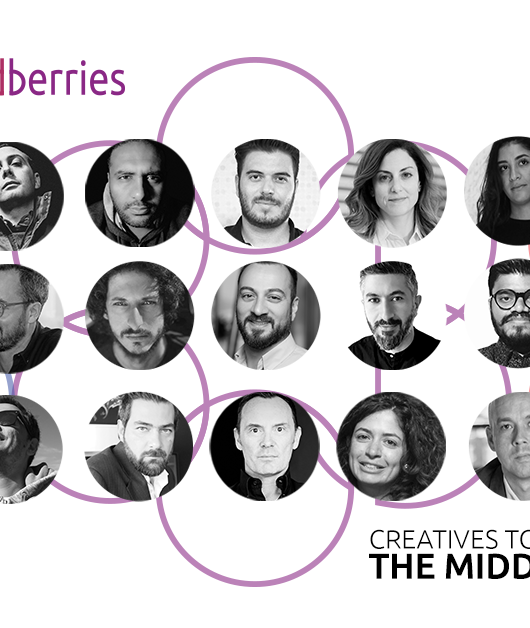2020 is over! Congratulations, you made it to 2021! It has been an exceptionally tough year for humankind. Covid-19 and its aftermath has completely reshaped the ecosystem which brands work in, consumers engage with and agencies service.
Today we’re debuting a Brandberries original ‘Breaking Into 2021: Reflections And Resolutions’; a content series in which we gathered the insightful opinions and reflections of the industry movers and shakers on 2020 and what to expect in 2021 for all communications disciplines; Brand Strategy, Consumer Behavior, Creative Industry, Digital Transformation and Brand Communications.
Amr El Kalaawy, Managing Director,

FP7 McCann Cairo
The implications of what we have been experiencing since Q1 2020 due to the COVID-19 pandemic has reached far beyond just a health problem as the pandemic has impacted every aspect of our lives. The social and the economic impacts of COVID-19 has resulted in a total shift of the marketing and communication industries, where brands, as well as agencies, were forced to deal with the new abnormalities of life. Still, I believe there is always light at the end of the tunnel, and that creativity is a key component in dealing with our novel realities. Creativity is the answer to any business problem, as it is not only needed in brand advertising, but in every other aspect of the business, especially in uncertain times.
Although creativity is key to any business’ success today, agility and flexibility are the keywords that shaped the marketing and communication industries throughout 2020, and will continue to shape it on the medium and long terms. The current generation of marketers and communication professionals had no previous experience or a case study reference – in modern history – of what course of actions should be taken during the pandemic, and so, we resorted to our experience and depended on our instincts to take decisions in hopes of minimizing the impact of the situation. While consumer needs and habits have been dramatically shifting, and in my opinion will remain to do so in 2021 in response to the pandemic, new opportunities will continue to surface; only brands and agencies that are flexible enough to create timely changes and reshape their marketing and sales activities will be able to capture these opportunities.
The same way the Egyptian revolution created big opportunities for brands on social media which boomed during the revolution, COVID-19 will be playing a pivotal role in the rise of Ecommerce. Due to lockdowns and social-distancing guidelines, Ecommerce has shifted to a new gear, where online shopping is turning into a necessity rather than a bonus option for shoppers across almost all categories. Today, 49% of consumers globally are stating that they will continue to shop online even after the pandemic. In Egypt, we have seen a significant increase in ecommerce transactions. For instance, FMCG sector as seen a rise of 110% increase in Ecommerce transactions, while in the real estate sector lead-ad conversions far reached 50% of total sales for many developers; this percentage is expected to grow further in 2021. Moreover, we are expected to see a rise in online-brand ambassador utilization, which tends to add more credibility and brand loyalty. We must, however, remain creative in how we develop their strategies in order to maintain an interactive experience for online shoppers.
Marketing and communication have been adapting to consumers’ needs throughout history; it is inevitable that the industry will continue to evolve with the changing socioeconomic dynamics of our new realities. Creativity accompanied with timely responses, especially on the digital space, will be key for marketeers and agencies to survive in an evolving world.

Managing Director,
Accenture Interactive Lead, Middle East
David Fregonas, Managing Director,
Accenture Interactive Lead, Middle East
There has never been a more dramatic global backdrop for Fjord Trends 2021 – by Accenture Interactive – in any of our 14 years. The recent events have shed light on the fact we still live with systems that are sometimes broken and often unequal—and consequently unfit for the challenges of the 21st century. Mapping out new territory is our meta-trend for the year ahead. As we look to the future, a wealth of potential worlds opens up in front of us. Some are scary, some are exciting, all of them are largely unexplored. 2021 will be about creating new maps to help us uncover what’s yet to come, and planning a route to the world we want to live in. We’re all exploring, which is creating a safe space for experimentation, prototyping and learning. Throughout history, after a global crisis, a new era of thinking has begun.
#1 – Collective displacement. In 2020, the world collectively came to know what displacement feels like. How and where we experience things changed, leaving us feeling disconnected from familiar comforts. While work to eliminate Covid-19 continues, organizations must find new ways to reach and communicate with people, and to deliver brand experiences at a distance.
#2 – Do it yourself innovation. For years, innovation has been driven by technology and devices. Now, it’s also driven by people’s ingenuity in challenging circumstances. There’s a pressing need for organizations to rebalance their innovation approach in response — to offer tools rather than solutions and to enable people to get more creative with how they live
#3 – Sweet teams are made of this. A reframing of our relationship with work, working hours and workspace has been underway for some time, driven by technology. This shift accelerated in 2020, creating a need for organizations to rethink the reciprocal employer/ employee contract.
#4 – Interaction wanderlust. The vast majority of us have been spending much more time on screens to interact with the world. Consequently, people have noticed a certain sameness caused by templated design in digital. Organizations should reconsider design, content, audience and the interaction between them to inject greater excitement into screen experiences.
#5 – Liquid infrastructure. How people experience and get hold of products and services was changed in 2020. Now, supply chains are under unprecedented pressure in recent history to meet new demands, placing stress on business models. Organizations should rethink their physical assets and refocus on points of delight in the last few feet before purchase.
#6 – Empathy challenge. Awareness and concern about inequality in all its forms grew rapidly in 2020. This poses a challenge: how should organizations manage the narratives they use to shape their brands? Companies may need a new approach that blends pragmatism with empathy, and that ensures they are seen to follow through on their intentions to do good
#7 – Rituals lost & found. The rituals that form the framework and coping strategies of everyday life have changed, disrupting the strong emotional ties associated with many of them. As people adjust, organizations must identify where they sit within this new context and how they can help build new ways for people to cope and reconnect.

General Manager, Commonwealth//
McCann Dubai
David Minkin, General Manager
Commonwealth// McCann Dubai
2021 – Food for Thought, The “C” Trifecta
Clients – Consumers – Communication Partners
Huh? Isn’t this article supposed to be about “Digital Transformation?”
Yes, it is. Allow me to explain.
No matter what transformation you aspire to, it will fail if all stakeholders in the Trifecta are not fully committed to change, and it will take innovation, collaboration and a willingness to embrace speed-to-market practices for the effort to be truly considered “transformative.”
Now you may be saying to yourself, “that doesn’t sound very digital or transformative,” and admittedly it’s not. But by the same token, any transformative digital solution must deliver on these fundamental principles or run the risk of failure.
Suffice it to say, the pressure for many businesses (and even perhaps their survival) may be just as great in 2021 as it was in 2020, so the lessons of 2020 cannot be tucked away in the hopes that a return to “normal” is just around the corner. Chief among them, the changes we’ve all observed in the customer journey, which if not taken seriously by our industry, will threaten our credibility as well as our clients’ futures.
If you haven’t done so already, tear apart your existing customer journey map and re-build it, armed with a microscopic understanding of your prospects’ behavioral idiosyncrasies –so you can use those insights to capitalize on the opportunities that may be missing from your current “map.”
Ask yourself, what are the most tantalizing trigger points to inject e-Commerce, Influencers,Gaming and Time-of-Day relevant Content into your prospects’ lives? What are the opportunities to perhaps ambush competitor communications?
If you commit yourself to this analysis, you’ll probably be surprised at the new and innovative ways you can dream up to engage consumers, whether it’s a cheeky way to encourage “live chat,” signing up for “notifications,” “completing a form,” etc.
The point is to take what we know are the existing and untapped “trigger points” and inject new creative approaches to getting on your prospect’s radar screen.
So now you may be asking yourself, what role does speed-to-marketplay in “digital transformation?” Well ask yourself this, is your agency & client set-up to take advantage of “unforeseen” ways to inject your client’s brand into fast-breaking or topical conversations?
Do you have an eco-system established that enables concept development, client / legal approvals, production and distribution in hoursvs. days, so you can claim “first-mover” status and secure a competitive advantage?
If you don’t, it’s time to re-think; because speed-to-market is the edge your clients need and if you’re not thinking and implementing this way, you and your clients may experience 2020 all over again.

Head of Strategy,
VMLY&R COMMERCE
Elias Bassil, Head of Strategy
VMLY&R COMMERCE
I think as agencies, we tend to make a “thing” out of anything.
That thing could be something new, something old, something done, something over used. But, regardless, we are masters in making it “the thing” that every client should be doing.
In 2020, that thing was digital. As if digital had died out and suddenly reborn.
Now, I won’t deny that I even fell down the rabbit hole myself, of digital pseudo sophistication. And every other sentence I used started to include words like VX, Zero-Click Solutions, Atomic Behaviors, Attribution Modeling and A/B Testing.
But amongst those words, came along concepts that actually weren’t just buzz-worthy, and rather significant. If I were to remove the weeds, I’d limit them to two.
The first is Digitization of Commerce.
The idea that shopper marketing has evolved.
With shoppers moving digitally, requiring creative sophistication in their experiences, how can brands modernize their tried and tested approach to grow relevantly?
We can see today that the fastest moving opportunities are related to D2C, e-tailers, digital store creations, social commerce and creative commerce solutions. And the stats support that, noting that this year our market has witnessed an increased spend of +127% from last year, purely on online commerce.
This opens up the doors to rethink the different steps shoppers take, how their browsing speed changes from one page to the other, and what differentiates wish-lists from instant gratification needs.
Is everyone on Amazon using prime and expecting a delivery to happen the next day, and are people on Instashop so unforgiving to a one minute delay within a 30min fulfillment promise? The behavioral data we can mine for, dissect and leap from is mind-blowing and certainly going to shape what we say, how, and how much we can mean it.
The second is Easy-going Content.
I know, it doesn’t sound like science. And that’s because it isn’t.
Today, the challenging world we live in and are exposed to has made everything complex and unfamiliar. We worry too much, we don’t know what’s going to happen tomorrow, and most of our sleepless nights are spent deciphering the information we read from news outlets.
And so in the midst of global discomfort, people need something simple, small and that can put a smile on their faces. That doesn’t mean they want to be passive, but rather active in something that can give them a breather from the burdens of every day life.
It has been proven that highest engagement and reach were achieved by brands who adopted the above and in short-form video challenges, with a case like Walmart’s #DealDropDance hitting over 80 million unique users.
I believe all social platforms today are forcing marketers and agencies to think beyond the conventional form of content funneling. Because the way people consume and engage is not set-in-stone, and it surely isn’t that predictable.
All in all, I believe 2020 has been a free masters class for every marketeer, brand manager, and agency specialist. And we can’t but be grateful that our world just got more challenging and thus more interesting. I see an exponential learning curve inspiring every individual in the field and the brands that embrace this first will be the ones steering the bandwagon.

Chief Commerce Officer,
PHD Media
Gemma Spence, Chief Commerce Officer
PHD Media
There’s no denying that Covid-19 has changed everything and no where have we seen more radical changes than in shopping. In fact, some brands like P&G and L’Oréal have cited that they have made 10 years’ worth of progress within eCommerce this year. Indeed, this has been driven by broad behavioural changes across all demographics in every country.
Simultaneously, we’ve seen attitudinal changes to spending online like shifts into essential shopping, going back to basics, focusing on local, loyalty offers and a dramatic shift into a more sharing and caring economy.
In turn, this has meant a huge sea change in buying types and uptake on new eCommerce modules such as subscribe and save, subscription models and buy now pay later.
We’ve also seen a significant rise in eCommerce retailers. And whilst verticals have different degrees of suitability to eCommerce, even industries such as apparel, auto and entertainment, have seen a huge increase in eCommerce share and penetration during lockdown.
What does this all mean?
Online retail has become and will continue to be the primary level for brands’ growth. It’s never been more important to stand out on the shelf. Brands must now be bold to catch the digital shopper’s eye to get sold.
So, what should brands be watching out for in the coming months?
With 2021 just around the corner and eCommerce on the top of every brand marketer’s mind, we asked our global Transact team what trends they expect to see come to the fore in 2021 and beyond…..
Acceleration in automation
Speed and agility will be the keys to success in 2021 as more brands will be looking to expand their online capabilities as well as streamline operational processes to ensure maximum order fulfillment is reached.
Ensuring availability will be crucial for retailers as they collect learnings from the spike in demand from 2020 and understand how to avoid future challenges.
As a result, flexibility within the supply chain will be an area of importance as brands pivot their focus to consumer analytics, evaluating inventory and trends in real-time to ensure a rapid response to demand increases.
Mobile commerce will become the main source of retail eCommerce revenue
The 2020 pandemic has seen a record amount of shoppers flock to the internet to make their purchases, especially given the restrictions on traditional in-store shopping by the lockdowns across the globe. Mobile commerce offers a unique ability to minimise health risks by reducing the time spent in-store through click and collect services, particularly when looking for same day acquisition when already on the move.
This growth coupled with the ease of access to mobile devices and increased mobile optimisations such as improved product content and online visibility as well as an easier path to conversion through streamlined mobile checkouts will see more and more users make purchases on handheld devices.
In addition, the growth of native applications for key retailers such as Amazon will ensure a streamlined experience for the user no matter where they are, with the ability to receive all of their usual benefits such as specific delivery windows and loyalty schemes that promote points collection and member discounts.
Acceleration of Seamless Digital Payments
Covid-19 has brought out many long-lasting behavioural changes, including the shift of momentum towards digital payments for many markets across the globe that have traditionally been cash reliant.
As a result, digital payments are now evolving to offer seamless transactions that blur the online and offline worlds. In 2020 we saw the rise of payment innovators like Tabby and Klarna accelerating eCommerce conversions with their pay later solutions.
In 2021, it will be the year of social and messenger payments. The launch and global roll out of Facebook Pay will accelerate WhatsApp and social commerce transactions across all industries of any size, enabling digital purchases to occur anywhere, anytime.
Advertising marketplaces will become even more congested
An increase in customers online will see an increase in brands online looking to sell their goods. Traditional brands will be focused on the online experience more than ever before, and the market will see a natural shift in marketing budget to achieve online growth.
This means that brands who already promote their goods on the key advertising platforms will see their CPC increase and conversion drop unless they have a robust strategy to protect their brands from the new wave of companies who now understand the size of the opportunity in eCommerce.
A need for greater transparency
With the launch of Amazon Attribution in the UK and Germany in October (and no doubt other markets in 2021), Amazon has introduced a way to achieve much greater transparency and cross-channel measurement.
However, other eRetailers currently do not allow such transparency and, ultimately, they will need to catch up in order to remain competitive.
With the boost that eCommerce has received from Covid-19, many marketers will be paying more attention to transparency and wanting more control.
As a result, eRetailers will come under pressure and will have to offer new solutions.

GroupM Lebanon
Hana Kaddaha Khatib, Managing Director
GroupM Lebanon
After a chaotic 2020 on a global level, more uncertainty is expected in the following year. The only guarantee we have is that 2021 will be a year of digital acceleration.
The global digital trends published for marketers to be attentive to in 2021 are related to USA & China mainly but many advanced MENA markets are expected to follow swiftly. Some of these key trends can be summarized as follows:
The shift to digital consumption will accelerate in 2021:
The COVID19 pandemic has driven online shopping globally, where first-time ecommerce buyers were created, and new shopping behaviors were nurtured. Online grocery, local group buying, and shoppable livestream, are well positioned to gain further traction across many markets.
As travel restrictions started to ease and with a broader rollout of COVID-19 vaccines- and possibly an end to the pandemic- the forecast is for retail ecommerce sales to grow exponentially in 2021. This is also expected to positively impact the industries suffered the most in 2020: Travel, hospitality, financial services & luxury goods.
First-Party Data Will Rule
The increasing restrictions on data collection and the death of the third-party cookie will mean that winning brands will place a greater focus on first-party data and owned channels. Thus, more direct-to-consumer (D2C) marketing.
For many brands, 2021 will be the year where brands will reinvest in anything that allows them to own and strengthen the direct customer relationship rather than going through intermediaries.
5G launch impacts digital acceleration
Countries counting on this next-generation networking technology to transform industries through digital video, virtual reality (VR), autonomous vehicles, telecom, and the internet of things (IoT).
Data Privacy will gain more traction:
This is evident in the USA that is expected to impact the rest of the world, where Over 70% of US adults favored some government regulation on how companies treat personal data.
An increased pressure coming from both consumers and advertisers is expected to push the incoming Biden administration to pass a Privacy bill at the federal level.
Digital Currency Electronic Paymentwill boost digital payment penetration
China is a pioneer on this front where a national digital currency was issued by China’s central bank, Digital Currency Electronic Payment (DCEP) will bring broader access to mobile payment to a greater percentage of the country’s population.
Virtual avatars will gain wider adoption among marketers
While the pandemic brings many in-person events to a halt, consumers are living their lives online in unprecedented ways, and marketers are seeking fresh means of interacting with them in a virtual environment. Companies are creating computer-generated characters known as virtual idols, which are finding their way into brand collaborations and livestreaming events. With the emergence of next-gen technologies such as 5G, and improvements in holograms and VR, marketers in China mainly are expected to ramp up investment in this untapped space.

Managing Director,
SAP Egypt & New Frontiers South
Hoda Mansour, Managing Director
SAP Egypt & New Frontiers South
2020 was an extraordinary year for every one of us on many fronts. It was a year full of challenges, unpredictability, and without a doubt new opportunity. We witnessed a pandemic that accelerated technological transformation across all organizations, shaking some of the old business models and introducing new ones. In order to thrive, survive and grow in such unpredicted times, brands should re-visit their vision and strategies to align their Digital Transformation strategies to focus on the following strategic pillars:
Create the TOTAL Customer Experience:A Customer experience that does not only focus on transactional customer satisfaction, but also takes into consideration the Brand presence, image and value. In addition, and to keep the brand alive and evolving, employee experience should be also considered as part of the Brand Value. Listening to the voice of your employees is what keeps the Brand innovative, and customer focused. Finally, it is not only about addressing customer churn, but also, anticipating new customer needs that might arise over time, and get ready with the right products just on time.
Build new revenue streams:Data is a very valuable asset not only for focused marketing but also to create new business models with new niche customers and partners to help create a distinguishable user experience.
Become an Intelligent Enterprise:Linking operations with customer experience and speeding up the adaptation process leads to a more agile go to market with higher levels of customer satisfaction. It is not only about visibility over resources and internal operations, but more about understanding and analyzing operational results, and revamping current processes to avoid waste in time and effort. These tasks increase your revenue, profit and help you control your costs.
Reorganize your team:as the business models are shifting, define your new vision, and get a closer look into your structure, team skills, and operations. Reorganizing your work force doesn’t mean reducing numbers, it means selecting and empowering the right set of workers to lead your organization through the transformation journey.
In brief, organizations are becoming more and more data collectors and processors. What distinguishes one organization from another is how quickly and accurately they can analyze and react to collected data. IoT, Social Media, and other data sources are widening customer visibility and preferences and using the right tools like AI/ML can help the organization discover knowledge (patterns) hidden in large volumes of transactions, and to advise/predict next moves. In brief, Brands need to become more Intelligent and socially aware.

CEO,
Robusta
Robusta
As we turn the page on 2020, oh and what a year has that been but we’re not here to talk about that today, and welcome 2021 with open arms hoping it’s going to be better, there’s always the yearly routine of watching out for what’s new that comes with the beginning of the new year, new decade, everything new that’s up and coming (also, how many times can we say new in one sentence?). And since we’re all about everything digital from experience to engagement, we asked our team to tell us the digital transformation trends they’ll be looking out for in 2021 and brought them all to you.
Omnichannel Evolution: Moving beyond just a seamless experience into a wholistic adaptive one
● Having different product ranges that complement each other and promoting different products on different channels will continue to become an important factor in the business growth, for example, businesses, especially F&B, that managed to create a variety of products to fit the home use like “Prepare it yourself” meals did not manage only to maintain their positioning during the pandemic but also gained reach to new personas.
● Capturing the essence of the offline experience in the digital one; a lot of people hit offline stores for the experience and not just the product, yet the pandemic drove people towards being more accustomed to the digital world.
Businesses that offer just a regular online shopping experience will fail to retain the “experience” customers and only those who manage to capture and evolve their customer experiences will thrive.
● Seamless transitions are becoming the new norm; you press a button to mirror what you’re watching on your phone onto your tv; you press play in your car to continue on that audiobook you were listening to at home. People are getting more and more used to those seamless transitions; in the same manner, the product I added to my cart should be accessible if I decided to pass by the physical store. I can check items on the physical store and pay on my app using a stored credit card that I don’t have. I should be able to check the fitting on delivery before accepting my order. Businesses are becoming more and more aware of that and as customers get more used to that kind of experience, they cannot just shift back to the normal online shopping experience.
Payment Models Upgrade: Focus on increasing the CLTV through increasing the purchase frequency and life span of the customer
● Subscription models versus one-time purchases: allowing customers to get more value and ensure they are committed & brand-loyal for a longer period of time.
● Flexible prepaid models where the customer saves through buying credit in advance and uses the credit later on for different services, not only does this gives the customer a sense of security as they understand there are multiple ways to utilize their spending and decrease their $ amount for the value they receive, but it also works better for the business’s cash flow.
● Financing options are no longer exclusive to the big players: all businesses regardless of their size need to provide their customers with flexibility in the payment terms and introduce financing and installment options. Whenever the uncertainty level increases customers are less willing to spend, paying in installments makes the initial decision much easier for the customers
Speed: The ability to push a minimum viable product fast enough & “reacting to market triggers in a period of 3 months or less”
Whether you already have a digital product or not, the ability to adapt fast enough to market changes is significantly needed; getting a product/feature out there fast will not only give you a first mover’s advantage, but will also save you resources, get you early user feedback and enhance your brand positioning. The ability to achieve this requires a brand/business owner to be able to let go of the details, prioritize effectively, and trust that digital transformation is not about achieving perfection, and rather about opening faster communication channels with your users to be able to gather the needed data to guide your growth. Getting something out to the market fast requires all businesses to also start looking at third-party ready-made solutions; not everything should match the business requirements 100%; business owners need to see what is available out there and make it work for them. Custom software isn’t fast nor cheap, so the best course of action is to start with an available solution and customize later.
Digital Monetization: The ability to monetize, online.
One of the trickiest points when it comes to digital transformation is how to monetize online; this is an easy answer for perhaps traditional e-commerce stores, yet it gets trickier with service oriented markets and platforms. In all cases, business owners need to be ready to host online payment and accommodate the service fee into their own calculations. However, in order to do that, there are some things entrepreneurs need to figure out first:
● Step 1 is to figure out how they’re going to conduct their service online; for example, the fitness market transformed to online sessions, high-end restaurants switched to delivery and some healthcare professionals started offering online examinations; what will work for your business?
● Step 2 is to figure out how much the online version of the service is worth; does it deliver the same value as the offline one? or more, or less?
● Step 3 is to know where to set up a paywall that will ensure the users pay for the services, yet it won’t block them from using the online solution completely. For example, in the healthcare industry, free medical advice can be offered as a welcome/entry, yet payment is demanded for a treatment program/service..etc.
User Migration: The ability to educate your users about your new systems and get them to migrate from the old ways to the new.
The final key point after getting a digital product/solution out there and figuring out the monetization strategy is how to get the users/target market to use the solution. If you’re lucky enough the trigger that caused you to digitally transform might push the users for you, as in the case of what COVID-19 did for most of us, most customers have opted for more online solutions in 2020 than ever before. Yet if that’s not the case here are some key points to have in mind:
● Price your service smartly, people are skeptical about digital value, don’t over shoot your prices at first.
● Offer a freemium model or subsidize the service for the highest value users.
● Invest in marketing; people trust what they can see showing
● Make it easy, don’t complicate things, don’t ask for too much information from the user, don’t require lengthy signups and registrations; the less the friction the better.
There you have it! These are the trends that we think are going to shape the digital transformation sphere in 2021 and we think every business, entrepreneur or product manager or developer should keep them in mind as they continue to innovate and provide great and memorable experiences to their customers this year.

Imad Sarrouf, Head of Publishers
DMS ( Member of the Choueiri Group)
Since the break of the new decade a year ago what we perceived as normal was fated to change drastically. Come April 2020 humanity was facing one of its most terrifying foes: the Corona Virus or as the world knows COVID-19. In a world where you could get infected just by being in relatively close proximity to one another, things were changing radically. The new normal seemed to curtail back any and every face-to-face interaction and had taken the brick-and-mortar venues out of action. With the old methods and platforms being rendered dysfunctional to a certain extent, full-time remote working and digital-only interactions have become the new normal.
Throughout 2020, we have seen a reduction or elimination in corporate spending worldwide. Marketing budgets are especially undergoing particular scrutiny. This has prompted professionals to look towards newer horizons yet again. We live in an era of doing more and doing fast with less effort. This means that marketers and other professionals can campaign for a radical re-setting of the decade-old traditional marketing strategies and make use of the technological advancements our generation has flourished with.
What has changed post-COVID-19?
This is a timely moment for those businesses and professionals who have what it takes to lead the way towards a transformation into digital-first approaches. However, before indulging into what practices are best suited for a digital-first approach one needs to understand what has actually changed post-COVID-19.
The COVID-19 crisis has brought about some serious implications for each and every industry. While some may have found this as an opportunity to level-up their business, while others had to postpone their moment of fame in their fields and for many others, this crisis brought bankruptcy for their businesses. A wide array of companies are now facing a laundry list of challenges, mostly pertaining to revenue and growth shortfalls, pressures from stakeholders and a drastic shift in customer needs and demands.
However, this crisis has also brought new opportunities for businesses but in order to turn things around what is absolutely necessary is enterprise agility and strategic pivoting of existing approaches. This means businesses can no longer afford to just “wait and see”. The main reason is that their clients need guidance to navigate the new terrain. One key takeaway is digital transformation and it is a continuous process. This is because of two main aspects; one being the constant evolution in new technologies and approaches. The other is because businesses, markets and organisations using these technologies will also need to change in order to keep up with it.
In order to stay in sync with this continuous process of digital transformation businesses and marketers will have to incorporate four additional values to their strategies. These are:
- Relevance:Business and marketing strategies need to assimilate newer configurations in order to assesscustomer/end-user needs post-COVID-19. Furthermore, these approaches need to integrate customer expectations at the current time as well as for future recovery scenarios.
- Sustainability:This refers to delivering a sustainable and concrete value in the short-term while anticipating a comprehensive, total-user experience from the start to the finish and beyond.
- Defendability:Business strategies need to add Defendability to their core values. This means recognizing and accurately assessing the impact of COVID-19 and thereby come up with a plausible solution for recovery.
- Differentiation:This simply means to set yourself apart and ahead of your competitors. In the digital transformation scenario, it is the ones who make the first move are the ones poised to achieve the greatest lengths of success.
Best Digital Transformation practices post COVID-19
Digital transformation and a digital-first business approach is not an easy feat to achieve. However, with some of the recommended best-practises businesses can take the leap of faith and bring about a total face-lift from the current crisis many of them are facing. So here are some of the best practices recommended by experts in the field.
- The Digital Customer Journey
In a post-COVID-19 world, the best place for marketers and businesses to make the largest digital impact with the highest ROI in the shortest time is none other than innovative customer experience or the ‘Digital Customer Journey’. This is what sets the best brands apart from the rest of the lot as they choose to remain relational. This means that they are more interested in building long-term customer relation and goodwill. This is what gives the highest ROI.
In order to bring about this ‘Digital Customer Journey’ into reality, three key factors must be integrated into the design:
Emotional Impact
This means that your business and/or marketing personnel needs to engage the customers in the most memorable fashion, somewhat surprising them with a personalized way so that they become inspired and motivated to take the next step of the journey.
Timeliness
Your marketing team needs to come up with original and high-valued contents at the right place at the right time.
Continuity
You need to point out an enriching aspect of your brand experience that sets it apart from the rest. This will create a sense of comfort, trust and optimism in your customers towards your brand.
- Scale & Rapidity
In the post-COVID-19 era businesses and marketers need to produce a lot more digital content and a lot faster, in a more personalized manner. An interesting example; Insidesource, a global furniture dealer, launched a digital magazine where they started an online competition; Quarantine Studios. Here participants could create their very own personalized furniture using various unconventional materials found in any household. The winner will have their furniture professionally produced and shipped to their home. This is a very intriguing way to engage customers at such times.
With the year passing into 2021 and with the world still crying out for social distancing, businesses need to focus on physical distancing instead of social distancing and yet keep engaging their clients with digital-first initiatives.
Visit my blog for more

Managing Director,
FP7 McCann Dubai
Jon Marchant, Managing Director
FP7 McCann Dubai
After a year like 2020, the idea of trying to predict the future is a little bit scary, but I will have a good go! One thing is more certain than others… there are certainly some stormy waters ahead to navigate in the short-term. The focus in 2021 therefore, for all our clients, will be on the bottom line. What can I create with my agency that will create genuine value for my brand and customers? We will need to adopt a language that the CFO as well as the CMO understands and so agencies that are comfortable proving the effectiveness of their efforts will be more successful.
I also predict bigger investments in content operations. Where clients are demanding even more for less, agency groups need to pool together resources and orchestrate omni-channel delivery at scale, and be given executive level backing at every turn to achieve this. Savvy marketers should embrace digital transformation by exploring creative ways of connecting with their consumers to drive demand through a broader mix of digital touchpoints in all of their campaigns. And with the continued absence of large scale events and in-person gatherings, we are likely to have much smaller events with much richer digital integrations based on the learnings from 2020.
As a result of lots of effort in integrating data across digital channels in 2020, we will see a further increase in the use of virtual agents by brands, assisting customers ina more conversational way, helping to traverse the complexities of modern life but in virtual forums, from changing phone plans to buying your next car. Given this heightened increase on voice and audio, agencies will therefore need to be crystal clear on the ‘tone of voice’ for their brands and the appropriateness of conversations with their consumers.
Contextual targeting in 2021 will be more sophisticated than ever before. With cutting edge technology, we can now ascertain the sentiment and emotion of an article, interpreting the content the way a human would. With these increased capabilities, we’ll see more advertisers take advantage of context targeting to drive additional value and greater alignment in their digital marketing campaigns.
Lastly, as machine learning in businesses becomes more prevalent, the role of the agency will evolve into being more strategic, helping clients determine what data should be looked at and how it can be utilized within digital marketing campaigns to generate significant ROI.

Managing Director,
Magna MENA
Lara Arbid, Managing Director
Magna MENA
Who would have predicted that in 2020, the core reason of an elevated digital transformation would be driven by a pandemic? Despite all of COVID-19’s negative impact, there is endless collateral in the form of thought leader articles to more lighthearted memes that ultimately puts COVID-19’s impact on digital transformation above what CIOs and CDOs have achieved in the past decade.
Businesses had to step back and do some house cleaning. This included identifying their gaps and fixing the basics to be able to compete in this new reality. Some brands were able to adapt faster than others to gain an early competitive advantage; others were late in to the party but managed to catch up and survive. However, a significant number of brands just couldn’t cope – and as time went by, we kept seeing new mainstream brands hit the headlines of going out of business. Cause for concern…
There are important lessons to learn from all this. A brand’s digital transformation is a journey, and for it to be successful, especially after the COVID-19 era, it needs to address some intrinsic values:
- Is it relevant i.e. does it meet the customer needs in an environment where expectations have never been higher.
- Is it sustainable and will it allow us to differentiate ourselves in the market?
- Is it data centric i.e. Data is no longer the new oil, but is a means for survival. How is this data being used to continuously enhance products and services?
For a business transformation strategy to be successful, it needs to be supported by the leadership of the company who need to drive this agenda. This is where priorities and ambitions need to be aligned while agility in decision making is practiced. Adopting the right technologies that will help overcome challenges and restrictions is a must.
It should be noted here that this drive of transformation needs to be embraced and practiced by all parties within the organization vs a selected few who have “digital” in their job title. This is essential to drive an overall shift in the culture to achieve the evolving business objectives. With this in mind, it is more important than ever, to ensure that the right talents are onboarded and retained within the organization; this means not only having people with the skills but also the right attitude of being agile and open to change.
In summary, brands have no choice but to be online, it’s imperative for businesses to double down on digital transformation, and to make it happen they need to keep an eye on the big picture and invest in the right places… more importantly the right people!

Co-Founder & Chief Business Officer
Halan
Mohamed Aboulnaga Nagaty, Co-Founder & Chief Business Officer
Halan
2021 will have many health-tech startups peaking since the covid made many investors and entrepreneurs eye this field more and more, things like home-care and ” pharmacy delivery ” and details with logistics in B2B pharmacy/pharmaceutical companies commerce like the ” MAxab of pharmacies”.
Also “Fintech 2.0″ will start rolling out in Egypt, Fawry and the likes ( Massary, aman and bee) and acceptance companies like accept and cowpay with the support of the new CBE regulations will pave the way for new client and Business facing fintech modules to reduce the ” paper cash ” in the market and also the remittances and peer to peer transfers and forward and backward integration with current fintech players and easier ecommerce checkouts and open banking apis can also flourish if the regulators are ok with it.
Last but not least, the hype and funding with pure harvest of UAE may also push several agri-tech startups to appear.

Head of LIVE ,
McCann UK
Monica Tailor, Head of LIVE
McCann UK
There have been some radical changes across all aspects of life since the start of the pandemic. At the beginning we talked about a return to normal which rapidly moved to a new normal. However ‘normal’ is something that is constantly evolving.
What is clear is that people are dramatically increasing their use of digital technology for work, shopping, gaming, and socialising, across all age groups.
This behaviour change could be seen as necessary due to various global lockdowns however some of the changes we’re seeing are actually an acceleration of trends we’ve seen emerging for some time. The COVID-19 pandemic has accelerated those trends and behaviours. Which means there won’t be a return to ‘normal’, the changes we’re seeing are going to stay for the vast majority of people and brands need to continue to adapt and transform to stay ahead.
Even before the pandemic hit, McCann Truth Central’s ‘Truth about Commerce 2019’ study found that 1 in 2 people globally would buy everything using a subscription service if they could. And this is even more pronounced amongst younger 18-34 consumers with 54% feeling positive about this way of shopping. This move to subscription services has been matched by brands through the pandemic. We’ve seen new and innovative launches of direct to consumer subscription services from essential cleaning products and groceries to meals, snacks and drinks.
Contactless payment is another great example, according to a global survey conducted by Mastercard earlier this year consumers are increasingly moving toward contactless card adoption due to the COVID-19 pandemic with 79% of consumers are using contactless payments globally (with this at a similar high of 70% of consumers in MENA). Consumers cited safety and cleanliness as the key drivers to adoption of contactless payment.
Maybe some of the most visible changes we’ve seen are in our society has been the effect of COVID on our shopping malls and retail experiences. Shopping has shifted to the internet, at times all retailers had to switch to primarily selling online only. Statistica tracks global website traffic and shows that traffic to ecommerce websites saw unprecedented levels – higher in June 2020 than the previous Christmas.
What’s clear is that some of the behaviour change we’ve seen is going to stay, can we predict what’s going to stay? Probably not but any behaviours that are seen as more convenient, safer and better value are likely to lead to lasting change. Now we’ve been through the pain of learning new ways to shop, interact, socialise, we’re likely to keep the parts that suit us best.
Digital transformation for every brand is happening in response to adoption of more digital services by consumers, brands now need to get on the front foot and look at not just digital services to survive but reimagine what the new digital future is going to look like.
https://www.wamda.com/2020/05/rise-contactless-payments
https://www.statista.com/statistics/1112595/covid-19-impact-retail-e-commerce-site-traffic-global/

Transact
Nagham Akileh, Senior Director- E-Commerce Strategy,
Transact, Omnicom Media Group MENA
2020 will undoubtedly be a year etched into our memories forever. While the global pandemic upended livelihoods and impacted economies, it has also forced industry leaders to accelerate digital transformations to safeguard their business and ensure continuity. It has been a year of much-needed agility, with businesses adapting to a growing set of consumer behaviors as they quickly embraced eCommerce to become an essential part of their lives, eroding any previous adoption barriers. As economies begin to recover in 2021 in parts of the MENA region, here are some trends to watch out for as brands continue their digital transformation journeys:
- Quick commerce was pioneered by food delivery apps, with fast delivery times in 30-60 minutes. We saw this implemented outside of that sector by Ounass, with 2-hour delivery for luxury items in 2016. Fast-forward to 2020 and eGrocery had to grapple with the surge in demand and delivery times went from same/next day delivery to 10 day waiting periods. Many retailers also experienced similar challenges. This resulted in a lot of focus on supply chain and logistics optimization and partnerships to scale e-commerce operations effectively. Food delivery apps were poised for success in the eGrocery space due to established logistics networks, and we saw leading players like Delivery Hero and Noon introduce these offerings across their suite of apps in 2020. While eGrocery will continue to be the core of the quick commerce trend in 2021- Jahez recently announcing further expansion within the GCC with a new service app called “Pick”- consumers are likely to expect similar offerings from their favorite brands across other retail categories they shop for.
What does this mean for brands? Brands need to streamline and optimize operations- be it through automated solutions or logistics partnerships- to enable them to maximize order fulfillment and delight customers as quick commerce starts to become a standard shopper expectation.
- Social commerce is an emerging trend that is here to stay, as users increase time spent on social media and social platforms deepen their vertical integration features. Social commerce growth stems from rise in mobile commerce, where retail mobile commerce sales in MEA made up 65% of total eCommerce sales in the past year, and accelerated by social platforms introducing native eCommerce capabilities within their apps- from online storefronts to shoppable ads and video streams. The future of commerce will play out in messaging apps- WeChat in China has paved the way to show us what is possible. In 2021, messaging apps like Whatsapp will start to play an increasingly important role in fueling social commerce growth as more native e-commerce features are rolled out.
What does this mean for brands? Brands with D2C offerings need to ensure they are vertically integrated within social platforms’ ecosystems to effectively use available features to further grow their share of online sales via social commerce.
- Blended retail will be a critical part of many brands’ digital transformation journeys, as lockdowns have caused a renewed need of going out among consumers, further blurring the line between online and in-store retailing. Ensuring repeat footfall requires innovative and engaging shopping experiences, and with 5G on the horizon, expect to see more brands develop customer journeys further- from product trials through augmented reality to virtual stores to personalization both online and in-store.
What does this mean for brands? Brands need to redefine the role of physical stores and optimize online user experiences to ensure customers have a consistent brand experience at every touchpoint. A critical component will be ensuring eCommerce and retail store tech stacks are well-integrated, with CRM playing a pivotal role, to use first-party data effectively to fuel growth. This may also extend into measuring success, unifying KPIs rather than treating each channel in silos.

Head of Services Marketing,
IBM Middle East & Africa
Oussama Barkia, Head of Services Marketing
IBM Middle East & Africa
The COVID-19 pandemic has disrupted our personal and professional lives in ways we couldn’t even imagine. While 2020 was a year of unprecedented challenges, it presented opportunities, and we can confidently say that the pandemic has accelerated digital transformation and technology adoption. In fact, some businesses and governments were forced to complete in weeks what may have in the past taken months or even years.
A recent study from the IBM Institute of Business Value (IBV) showed that 60 percent of executives surveyed indicated that they are using this time of crisis to dramatically accelerate their company’s digital transformation. And fully two-thirds said that the pandemic has allowed them to advance specific transformation initiatives that previously had encountered resistance.
Digital transformation is about leveraging technologies to re-invent and improve your business. Technology is now a core strategic foundation for most enterprises and can be a key determinant of organizational survival and success. We see Hybrid Cloud and AI to continue to be core technologies that will help organizations fully leverage the power of digital transformation in 2021.
Whether responding to changes in the economy, buyer behavior, distribution networks, consumer tastes, geopolitical realities and the climate—businesses are becoming increasingly digital and increasingly dynamic. Cloud technology will offer the flexibility needed to be agile and resilient.
Today, most businesses are only 20% of the way into their cloud journeys, the next 80% is about shifting core business applications and workloads to the cloud, extracting more data and optimizing every part of the business, from supply chains to sales. Working with clients, we have seen that a ‘one-cloud-fits-all’ approach doesn’t work. Companies want the flexibility to run their critical workloads across any platform without having to rewrite everything as they go, they are choosing multiple cloud providers and platforms to best meet these broad range of needs—from building banking solutions, to running airline reservation systems, to responding to seasonal capacity demands. We’ve also learned that every client journey to cloud is unique, with efforts focused on specialized application tasks, workloads, security and compliance requirements, along with specific industry and customer needs. A hybrid cloud approach allows organizations the flexibility to balance the need to keep some workloads on-premise or in a private cloud while also taking advantage of the speed and flexibility of the public cloud. It’s major shift in the evolution of enterprise IT.
Disrupting every industry and our day to day lives continues to be artificial intelligence (AI). It has reinvented the traditional ways of doing business and interacting with stakeholders.
It’s critical to understand that AI is not one technology. It is a set of technologies and building blocks that include natural language processing, machine and deep learning, neural networks, virtual agents, autonomics, and computer vision.
AI capabilities are rapidly maturing. And so, too, is enterprise adoption. More executives than ever before are actively conceiving where and how to leverage AI but many businesses struggle as they move from AI experimentation to implementation of AI at scale.
IBM has gone through many transformation in over 100 years. We are now in a Multiyear transformation and will continue to be laser focused on open hybrid cloud platform and AI solutions, unlocking the full value of the cloud for clients and further accelerating adoption of the platform.

Head of Agency Development – MENA,
Rabih El-Khoury, Head of Agency Development – MENA
Former New York Knicks and Houston Rockets coach Jeff Van Gundy once said, “if you’ve waited until halftime to make adjustments, you’ve already lost.” Responding to a reporter, Bill Belichick, one of the most successful NFL coaches of all time was more Spartan: “Halftime adjustments, I mean that’s ridiculous.”
March-April 2020 were sort of a halftime for companies, ushered not by a referee but by the Covid-19 freight train crashing through business foundations bringing everything to a mental, organizational, and logistical halt. This made any “adjustment” attempts all the more painful.
Simply put, companies that had implemented or were well into their process of implementing core, digital-centric changes leveraged their position and outpaced competition who had lagged in effecting the needed change.
Having observed and serviced companies along this spectrum of readiness, I highlight three takeaways, which I believe are foundational for 2021:
1. Digital transformation remains equally–if not more–about implementation than design. It is about people and processes. Have you deployed, tested, and are continuously adjusting the process of handling your 500-a-day customer inquiries/comments, coming in across channels, now that you have your SKUs online? What are you doing with all that data? A quick search of digital transformation challenges reveals most are operational. 2021 promises no less action: vaccine, no vaccine, lockdown, no lockdown, travel yes/no, schools yes/maybe/hybrid. It isn’t sufficient to digitize (that ERP or that listening tool or whatever); companies need to perfect their processes that enable data-driven decision making in order to pre-empt, swiftly seize an opportunity, or be able to pivot when needed.
2. Companies that ideated and shared their proprietary data with their partners were primed to win, or at least in a position to stem the bleeding. At Twitter we partook in sessions where we, the client, media and brand agencies analyzed data, assessed scenarios, and weighed investments vs. outcomes to develop communication strategies. This wasn’t always the case. To have ‘transformed digitally” requires a mindset across teams—and processes across the organization—that makes data central to the conversation both in design and in implementation. From UX to taxonomy to attribution (hello cookieless 2021) to call-center data, to in-store sales, an open-book (whenever legally possible) is evermore a prerequisite for long-term sustainability, maximising impact, and smart course-correction.
3. Commit to the basics of digital media best practices. A large number of MENA clients still produce unoptimized assets, allowcopy to wear out, and don’t act on the pre- or post-campaign insights shared by their partners. Others do quite the opposite and reap the rewards (see their case studies on marketing.twitter.com). When the pandemic hit, many companies retracted to their safe-zone (last-click, reach & frequency, video views counter, rehashed TV copy… or doing nothing). This may have been a tactic carved out at halftime but going in 2021 true digital transformation requires a courageous commitment to explore and implement best practices. These drive results and the evidence is clear.
Digital transformation is innovation. Innovation isn’t tech, tools, or new talent alone . It is the implementation of answers to tough questions.

Associate Partner, Digital,
PROPHET
Samantha Papadakis, Associate Partner, Digital
PROPHET
In 2020, we witnessed companies go from nascent start-ups to household verbs (Zoom); brands shift from creature comforts and conveniences to life-lines (Amazon, Instacart); industry incumbents humbled by entirely new models (Moderna). And it was the year (finally!) that talk of transformation went from theory to reality.
As we start a new year, all too eager to look forward and put 2020 behind us, I can’t help but think of 2021 as less of a fresh start and more a continuation. If 2020 was the catalyst, 2021 is the incubation – the year to nurture, deepen, and foster the groundwork that was laid (so painfully in some cases!) in 2020. 2021 will be less about adapting, and more about enhancing— staying a course that emerged out of necessity, but blossoms into new business models and ways of working that transform the business if invested in and nurtured properly into 2021 and beyond.
I’m reminded of a quote by a colleague and brand leader, David Aaker, who once remarked “a brand is a promise to customers and a challengeto employees.” In 2021, much in the same way, digital transformationwill be the promise to the customer, and the challenge to employees – to further build and deliver what was catalyzed into action in 2020.
With that, we see five areas where “adapt” must evolve to “establish”
- From Phygital to Virtual: For years we’ve seen the physical model (slowly) make space for digital – mostly by bringing digital into the physical space. In 2020, we saw what’s possible with no physical at all, which now raises the bar for what consumers expect: no store visit, live commerce and consultation, seamless e-commerce, convenient (and contactless) delivery. Establishing these adaptations into new models is a must, particularly for retail, beauty, and F&B industries.
- From Online to At-home: While many consumers cherish the idea of being able to go out and reconnect with normality, many have formed new habits. The convenience of “at home” will persist, forcing digital to evolve beyond a supplementary service (e.g., accessing services “out of the store”) to designing for, and around, a new nexus of life. This is especially true for retailers, entertainment providers, and fitness brands who will now need to re-think, and re-design, digital experiences accordingly.
- From Partnerships to Platforms:Companies across industries showed tremendous resourcefulness during 2020 in creating new solutions through partnerships. In India, for example, P&G partnered with Swiggy, a food delivery app, to deliver essential household products to consumers in the absence of a delivery supply chain. The brands that continue to invest in new partnerships across the value chain can evolve to larger one-stop-shop platforms that customers turn to consistently.
- From Convenience to Contactless: In a post-COVID world, convenience is no longer simply about speed or being frictionless, it’s also about being contactless – completely eliminating the need for human interaction, whether that be from an in-person consultation to delivery. Take Nike Fit, enabling customers to find the right size shoe by scanning their feet. A once-novel feature can now serve as a critical means for shoppers to instantly find what they’re looking for, with zero contact.
Companies that were able to capture these market shifts and accelerated their transformation will undoubtedly gain the upper hand in the coming years. However, transformation doesn’t stop here. It is also imperative for organizations to evolve their leadership, operations and culture, in order to enable digital long-term, in 2021 and beyond.

General Manager of Global Business Solutions, MENAT,
Tiktok
Shant Oknayan, General Manager of Global Business Solutions, MENAT
Tiktok
2020has undoubtedly been a time for self-reflection for brands and consumers. We are now more self-aware about what we invest our time and energy in and for many of us, this has inspired rekindling old loves, exploring new interests, or enjoying the simple pleasures in life.
Off the back of this period of uncertainty, we’ve seen a rapid acceleration to everything becoming digital and it has meant that we have had to adapt the way that we communicate – both in our personal lives as well as professionally. As a result, we have witnessed a shift in how people discover and consume digital content and have seen phenomenal displays of originality in a world that is now almost entirely ‘online’.
Today, people are signaling with their thumbs, their cameras and their voices that they want positive emotions. To laugh, to be inspired, to be amazed amongst all the uncertainties happening around them.
As the year comes to a close and with the hope of a new, more prosperous year on our doorstep, here are the 2021 marketing trends that will allow brands to stand up and continue playing an integral part in consumers’ lives and shape the coming year.
The definition of influence
The rise of the content graph will have one very unexpected outcome – people will not follow others because they are famous, they will follow them because they are good at entertaining, engaging and informing. This means that a single piece of content can propel someone to the top of the popularity charts for that day or week.
This represents a paradigm shift for brands. It means that the influencers they work with will become less fixed – they will have to be on the ball, align campaigns to different talents to ensure inclusion, regional relevance and relatability at different moments or within different contexts.
Speed + Authenticity > Production Content Quality
People want content, and a lot of it. They want to be entertained in a way that is authentic, readily accessible and inclusive. And they are willing to forgive content creators for not being perfect if they are human.
Brands can choose to produce one piece of amazing content that will have a shelf life of three days on one of the new platforms or decide to be down to earth and produce greater volumes of less formalized and authentic content that helps them build lasting relations in this new community.
The primary screen is vertical
A generation that is used to ‘always on’, on demand content is also a generation that doesn’t like to commit to things for too long; meaning longer form content requires them to carve out separate time.
It is important for brands to think 9:16 and vertical first if they want to engage this new audience – they don’t watch TV and if they do, they certainly don’t watch the ads. When and if they do, as soon as the ad comes on, they switch to their phones. Focus on the screen that isn’t competing with any others.
Non-traditional communities will pave the way
Today, people have more choice than ever as to who they spend their time with. Social platforms are only really fun if you know people on them and content platforms allow people to bond over, collaborate around and co-create based on interest.
Lookalike targeting by traditional demographic factors such as age, gender and location won’t matter as much when deciding on audiences. Media planning will need to evolve to move away from this type of targeting to understanding audience behaviour and interests in a way it never has.
One ecosystem or you miss out
More time on internet connected devices, the dominance of e-commerce, and changing customer expectations means people have a whole new set of expectations as to what makes a good user experience.
Planning between marketing and sales, especially online sales, cannot happen in a silo. Brands may have been forgiven for it six months ago, however if a user can’t buy what they see in front of them in three clicks now, they will go somewhere else.

Managing Director,
Isobar MENA
Ziad Ghorayeb, Managing Director
Isobar MENA
2020 has been a year of both polarization and radical collaboration. One that has inspired unprecedented levels and speed of change in almost every aspect of life. The creative and technology industries, arguably more than most. Across our creative brands at dentsu we have identified five key themes that will coexist, combine and recombine to shape a ‘Brave New Normal’.
- The Virtual Experience Economy
Accelerated by the pandemic and enabled by 5G, we will see a dramatic increase in virtual products and experiences. Unrestrained by the physical space, we will reimagine what a concert, conference, class or even product can be. How much would you pay for virtual fashion?
For brands, this means that thinking about VR and AR is no longer optional. In a world where brands are built just as much in the virtual world as the real, we need to be thinking about using technology & next generation personalisationto reach audiences in a more engaging and memorable way.
- The Real We
In parallel, we will see a powerful desire for simplicity and authenticity. Front line workers, farmers and activists are our new heroes. A new commercial model is emerging rooted in direct, disintermediated relationships between creators and the communities they serve.
As we adapted to doing photoshoots at home, with both brands’ employees and local community members becoming the new actors, we were met with a much wider pool talent and opportunities that has enabled brands to become much more credible and real.
- Human Contact-less
As contactless technologies make stores less human, online commerce will become more social and more personal, powered by next generation live streaming platforms. Get ready for a “QVC for Generation Z”, to reimagine stores as studios and staff as entertainers.
For brands, the expectation for exceptional service online has never been higher, as people turn to virtual try on or try ins – bringing the point of purchase and transaction ever closer.
- Me, Myself and AI
Amidst the pandemic, personal health data becamepublic property. In a future where Alexa candiagnose a cold, cars can identify distracted driversand our bank accounts can track our carbon footprint,we expect an ongoing tension between privacy,personal wellbeing and public interest.
Is your brand contributing to customer’s physical and emotional wellbeing? How are protecting their privacy, and how are you using your newfound first-party data to deliver personalisation? These are the questions CMO’s need to ask themselves going into 2021.
- The Urgency of Allyship
Alongside individual wellbeing and as social inequalities widened, we saw new-found urgency around brands as a force for social good. Going forward, we will see brands step up as allies in driving structural and systemic change.
More than ever, brands need to think about the wider societal impact of their decisions and align belief and behaviour as never before.
Find out more insights and inspiration for 2021 and beyond by downloading the full report today. Download here.





